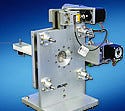April 14, 2010
|
A stent-securement tester is the first off-the-shelf system of its kind. |
If a stent dislodges prematurely--even slightly--from its delivery system while inside a patient, consequences can range from incorrect placement of the device to surgery. To help prevent such dire mishaps, stent manufacturers must comply with various international testing standards and guidance documents; however, an off-the-shelf stent-securement testing system has not been available to produce repeatable, reliable results. Machine Solutions Inc. (MSI) is looking to change that.
"The SR1000 is a piece of testing equipment designed specifically to measure how much force it takes to dislodge a balloon-expandable stent from its delivery system," says Melissa Lachowitzer, MSI product manager. "This test is required by FDA and other regulatory bodies in other countries, [but] there's not an off-the-shelf piece of equipment that does this test."
Testing of stent-retention forces is typically performed using in-house tape or shim methods. The former entails placing tape onto the stent and pulling the tape's tabs using a tensile testing system to measure the force; the latter evaluates proximal and distal forces against displacement. "There are all kinds of in-house-developed tests, but even the really well-used in-house tests do not produce very repeatable data, and they're very difficult to set up, so the repeatability and the reproducibility of the data that people are currently able to get is not there," Lachowitzer says.
By removing operator variability, the SR1000, in contrast, yields repeatable and reproducible data, according to Lachowitzer. Engineered with a multisectioned segmental head, the system obtains retention forces by gripping the balloon with one set of segments and capturing the stent edge with the other. The heads then separate to dislodge the stent from the delivery system.
Among the system's benefits is the ability to perform proximal or distal displacement of the stent from the balloon without modifying the setup. The tester is also equipped with diameter control and force feedback on the capture segments, which allows for a repeatable diameter opening and identifies how much force is being exerted on the balloon, respectively. If the force is too high, users can stop the test and adjust parameters to avoid false readings or false pulls. Additional features include visual assist with sample alignment, video capture of the test, and real-time graphical display of force versus displacement.
These features, and the fact that the SR1000 was designed to satisfy testing recommendations suggested by FDA, ASTM F2394-07, and the ISO 25539-2:2008 standard, enable OEMs to have increased faith in the manufacture of their stents, Lachowitzer proposes. "With this repeatable method of testing securement, they're going to be able to put a product onto market that they feel very comfortable with and confident in its securement to the balloon."
Machine Solutions Inc.
Flagstaff, AZ
www.machinesolutions.org
About the Author(s)
You May Also Like



